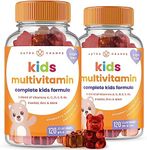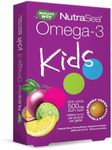Buying Guide for the Best Multivitamins For Kids
Choosing the right multivitamin for kids can feel overwhelming with so many options available. The goal is to support your child's growth and development, especially if they are picky eaters or have specific dietary needs. It's important to focus on the essential nutrients, the form of the vitamin, and how easy it is for your child to take. Always remember that a multivitamin is meant to supplement a balanced diet, not replace it. Understanding the key features will help you make a confident and informed choice.Nutrient ContentNutrient content refers to the types and amounts of vitamins and minerals included in the multivitamin. This is important because children need certain nutrients for healthy growth, such as vitamins A, C, D, E, and B vitamins, as well as minerals like calcium, iron, and zinc. Some multivitamins offer a broad range of nutrients, while others focus on just a few. If your child has a restricted diet or specific health needs, look for a formula that fills those gaps. For most kids, a multivitamin with the basic daily requirements is sufficient, but always check the label to ensure it matches your child's age and dietary needs.
Form (Gummies, Chewables, Liquid, Tablets)The form of the multivitamin affects how easy and enjoyable it is for your child to take. Gummies and chewables are popular because they taste good and are easy to chew, making them great for younger kids or those who dislike swallowing pills. Liquid vitamins are useful for very young children or those with swallowing difficulties, as you can mix them into food or drinks. Tablets are usually for older kids who can swallow pills. Choose the form that your child will take consistently and without fuss, as regular use is key to getting the benefits.
Age AppropriatenessAge appropriateness means the multivitamin is designed for your child's specific age group. This is important because nutrient needs change as children grow. Multivitamins are often labeled for toddlers, children, or teens, with different amounts of each nutrient. Using the right age group ensures your child gets the right balance—too little may not be effective, and too much of certain vitamins can be harmful. Always pick a product that matches your child's current age.
Additives and SweetenersAdditives and sweeteners are extra ingredients used to improve taste, color, or shelf life. Some multivitamins contain artificial colors, flavors, or sweeteners, while others use natural alternatives. If your child has allergies, sensitivities, or you prefer to avoid artificial ingredients, check the label carefully. For kids with dietary restrictions or sensitivities, look for products labeled as free from common allergens or artificial additives.
Allergen InformationAllergen information tells you if the multivitamin contains common allergens like gluten, dairy, soy, nuts, or eggs. This is crucial if your child has allergies or intolerances. Many brands offer allergen-free options, but always read the label to be sure. If your child has a known allergy, choose a product that clearly states it is free from that allergen to avoid any health risks.
Certifications (e.g., Non-GMO, Organic, Third-Party Tested)Certifications indicate that the product meets certain standards, such as being organic, non-GMO, or tested by a third party for quality and safety. These can be important if you want extra assurance about what’s in the bottle. For example, organic or non-GMO certifications mean the ingredients are grown without certain chemicals or genetic modifications. Third-party testing adds a layer of trust that the product contains what it claims and is free from harmful contaminants. Choose certifications that align with your family's values and health priorities.
















